Summer Vacation on the Front Lines of Palestine
Do NGOs that work in and around Israel use their volunteers for propaganda?
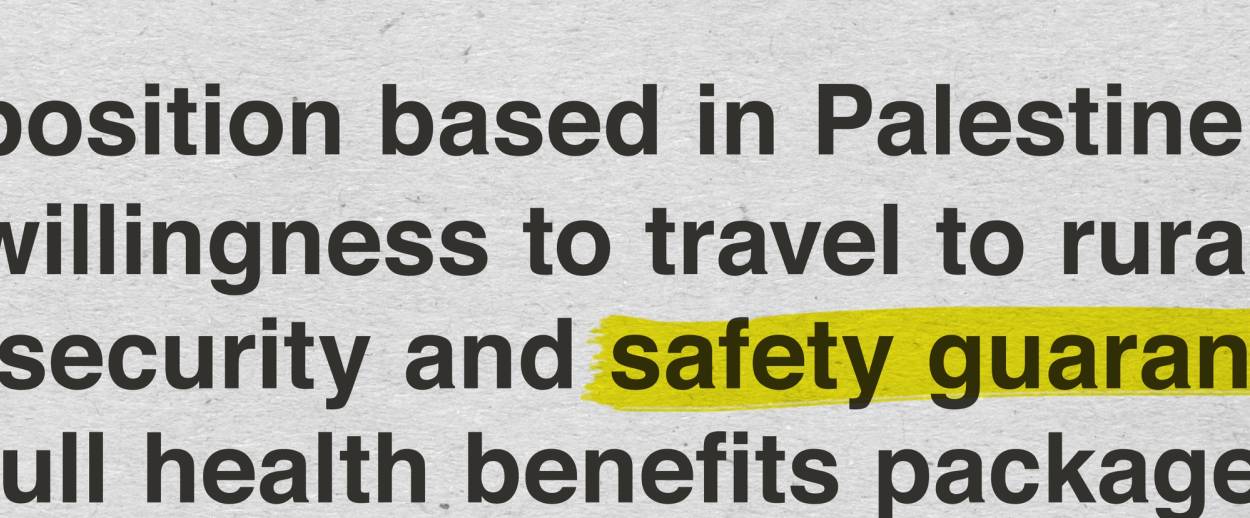
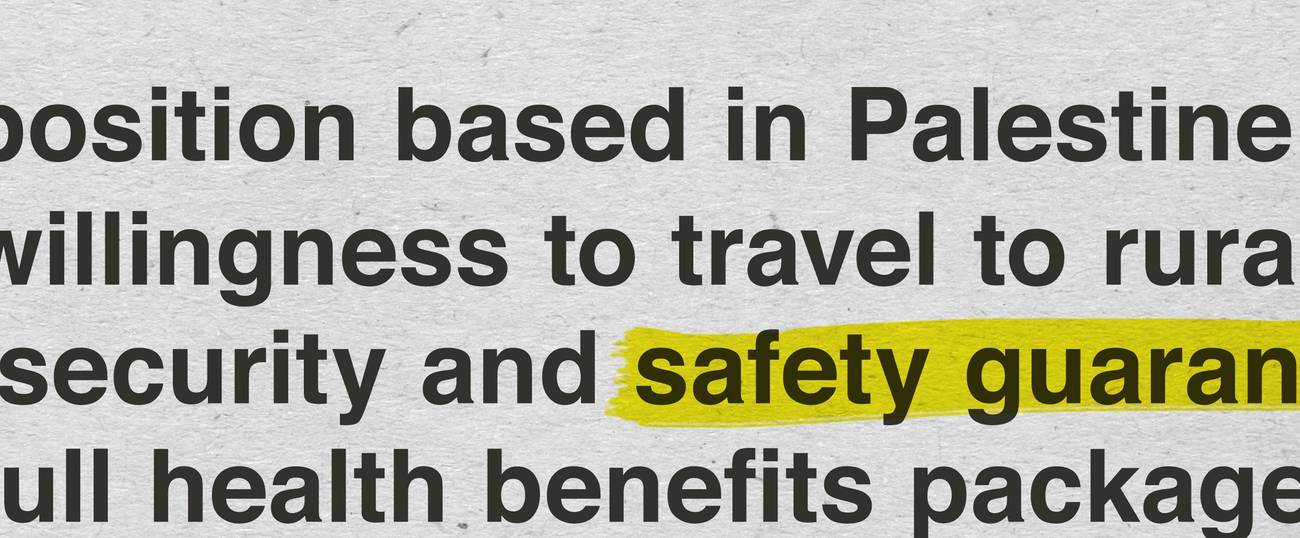


The “brutality” of the Israeli occupation of the West Bank and Gaza is a central pillar of the BDS movement, which regularly claims that the people of the West Bank and Gaza are being dehumanized, massacred, and expelled. I am familiar with these claims, because I regularly attend BDS events. For example, on March 10, during “Israeli Apartheid Week,” I was at the University College London to hear two Palestinian university students, sponsored by an NGO called CADFA, speak about their experiences. CADFA—which stands for “Camden Abu Dis Friendship Association”—receives frequent criticism because of its open bias against Israel and tendency to lionize terrorists.
The primary purpose of CADFA’s presentation was to bombard the UCL community with stories of soldiers constantly entering classrooms, of interruptions during the school year, and of students being arrested simply for not being Jewish. This alleged denial of Palestinian academic freedom is a driving force behind the academic boycott of Israel. This from the U.S. Campaign for the Academic and Cultural Boycott of Israel (USACBI) website:
It is Israel—not those who participate in the academic boycott of Israel—that denies academic freedom and more fundamental freedoms to Palestinians.
And again from the recent BDS vote at the Doctoral Students’ Council (DSC) at the City University of New York (CUNY):
The endorsed resolution calls for solidarity with Palestinian institutions, academics, and students who have been denied their academic and other freedoms by Israel.
Yet, in the real world, none of this is true. How do we know this? Because my colleagues and I asked the Palestinian institutions directly, and they told us that these claims are false.
In January, Sheri Oz ran a piece on her blog, Israel Diaries, titled “Situation in Palestine is Normal—No Need for BDS.” Sheri wanted to address the idea of the hypocrisy of the Academic Boycott, and contacted universities in the Palestinian areas asking them for basic safety information about studying there:
Can you please send me information about the course—times, costs, accommodations, travel instructions and, of course, information for my parents as they are worried about the safety of going to Palestine. (email sent to An-Najah University in Nablus on 22/12).
An-Najah sent this response:
I meant there is nothing inside Nablus some problems happened on checkpoints. any way we live a normal live, the media exaggerate the news and media amplifies this news —(from email received from An-Najah University in Nablus on 23/1.)
Other universities responded in similar fashion. This from the University in Bethlehem:
Since the establishment of the institutions hundreds of students came from different countries and nothing happened to anyone of them. No one can guarantee that Paris, America or any other country is saver than here in these day. At the end it is personal issue. If one is careful, he could survive everywhere. Salamat
Sheri also received responses from Birzeit University in Ramallah and the Arab American University in Jenin (the two students giving their presentations at UCL were both from Birzeit). No institution contacted suggested that safety was an issue or that the academic year might be threatened by reality on the ground. The response from Bethlehem was especially interesting because it seemed to imply that getting into trouble was “a choice.” The issue of “choice” was to resurface far more forcefully later on in our investigation.
While propaganda in the West suggests that Palestinian Arabs are living in constant peril, a university seeking to attract international students, or an export business wishing to project the image of a reliable source of products, must deal more carefully with the truth. NGOs operating in Palestinian areas face a particularly absurd situation. These aid agencies are in a constant competition for attention, driven by the clamor for donations and funding. A failure to continually convince people of the urgency of their cause would result in financial disaster. Yet most if not all of these organizations also desperately need volunteers—and might well be liable if they gave them false information that led to personal injury.
There are hundreds of websites dedicated to providing information on volunteering opportunities worldwide and almost all of these sites contain a section on Palestine. One of the main concerns, wherever the NGO is based, is always safety. The African Volunteer Network, in a section on Somalia, as well as the group Hand in Hand for Syria both explicitly state they cannot send nonmedical volunteers into their specific areas because of the dangers. So how can there be so many aid agencies advertising for volunteers in Palestine? How can there be NGOs claiming Israel is conducting “genocide,” and is engaged in “war crimes” at the same time as organizations advertise for volunteers to help plant olive trees, teach English and work in refugee camps?
I contacted organizations advertising for volunteers to the area and asked about the safety of volunteering in Palestine. This list included: UNWRA, B’Tselem, Rabbis for Human Rights, Physicians for Human Rights, The Excellence Centre, Project Hope, International Solidarity Movement, Camden Abu Dis Friendship, Passia, ACDI/VOCA and over a dozen others. Their responses were noteworthy. The International Solidarity Movement (ISM) is one of the notorious Palestinian led activist groups. They deliberately seek out confrontation with Israeli troops. Although they claim to support only “nonviolent resistance,” The Daily Telegraph has called ISM “the ‘peace’ group that embraces violence.” ISM responded quickly to the inquiry, and also directly dealt with the security concerns raised. Its response, signed by the “Ramallah Team,” makes for illuminating reading:
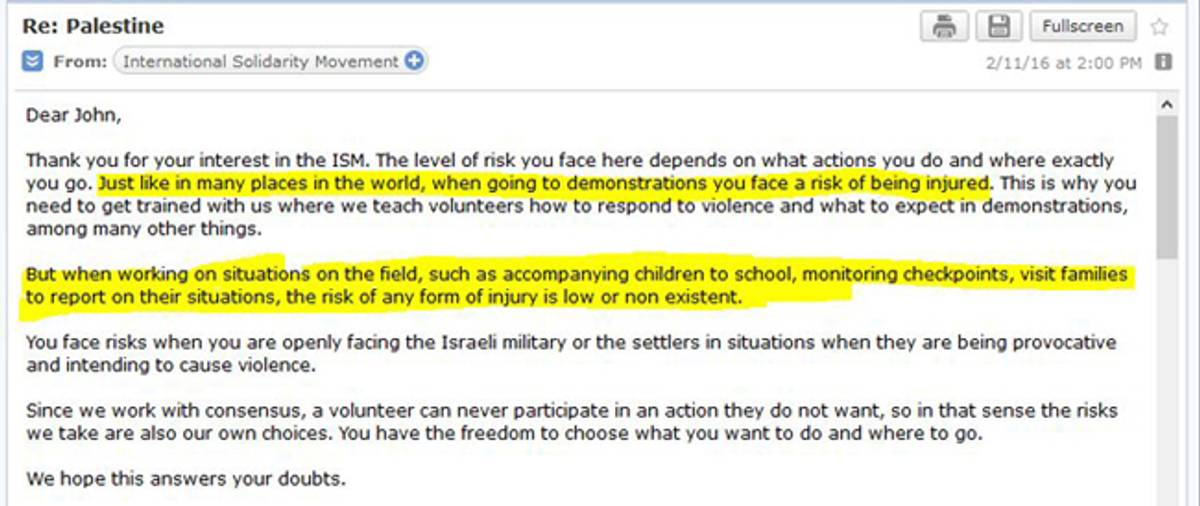
The organization points out that injuries can occur at demonstrations. It suggests this is natural, and would occur if one were to take such actions in “many places in the world.” It states that when one is working in the field, at checkpoints, schools, or in the towns, the risk of any injury is “low or nonexistent.”
When you place these two clear-cut statements together, it creates a problem for ISM’s position. Israelis are not attacking the Palestinians, but rather in areas where Palestinians choose to confront Israelis, violence can occur. But if you follow the logic, the inevitable conclusion is worse. If as ISM claim in the email, you face risks when the Israelis are intending to be provocative and cause violence, how can everyone also be safe? The only logical answer becomes, that the acts of violence occur only when ISM creates them.
Having realized that the face ISM uses to attract volunteers exposes both that Palestine is relatively safe and that the Israelis are responding to aggression rather than starting it, I began to look at the ISM’s other face, the one it projects to the wider community, the one of the “brutal occupation.” This from an ISM journal in October 2015: “Among the first victims of this genocide is the truth, so it is our duty to prevent mass media outlets from turning Palestinians into ‘terrorists’ who always ‘die’ in an ‘ongoing terror attack.’ ” This from an organization who had just told me that general risk of any injury is almost nonexistent. This is one of the headlines on the website at the time of the investigation. It read “Daily violence on the way to school.”
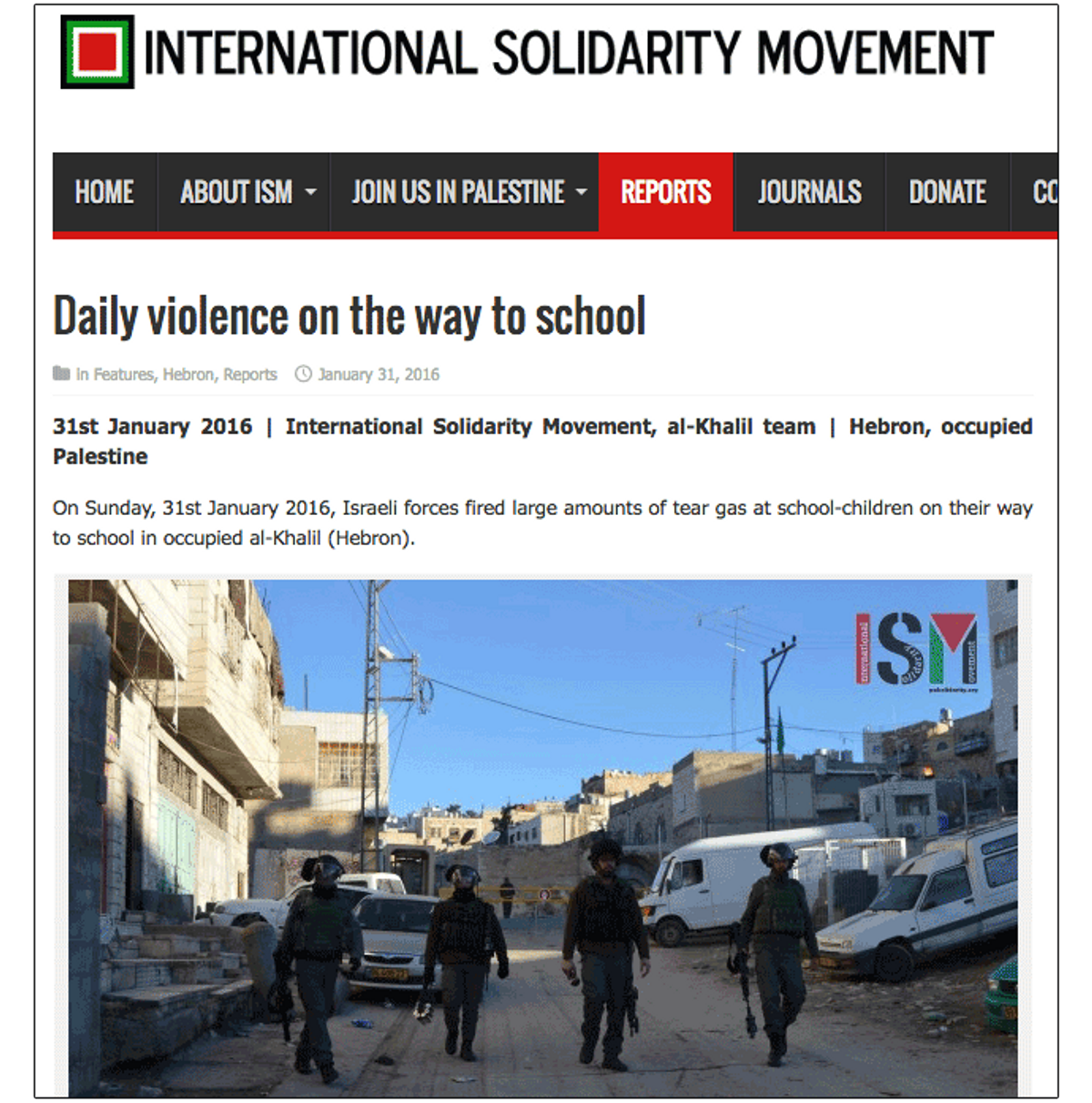
Hebron is almost always on the agenda, and all tours intended to skew perception never forget to stop there. With the time and place of these tours always known in advance, it isn’t difficult for extremists who want to project an image of Hebron being violent to make sure that this is what groups see when they come—and that cameras will be there to make sure the “spontaneous demonstration” becomes headline news.
So is Hebron as bad as these NGOs keep telling us it is? This question is answered by a website set up inside Hebron advertising for volunteers. This from the Excellence Centre:
At first one may think that Palestine, Hebron in particular, is an unsafe destination for an international visitor. This is due to two main reasons. Firstly; the fact that Hebron is a conservative community and secondly; due to the presence of the Israeli occupation soldiers who patrol the checkpoints which mark the division of the Old City of Hebron. However, this image of Hebron is unfounded. In reality it is very safe for internationals, both men and women, to visit, live and work.
The Excellence Centre, in a desperate attempt to show the “real face” of life in Hebron, also produces a video of volunteers talking about their experiences.
The volunteers talk about how safe Hebron is and explicitly criticize media hype and sensationalism. The Excellence Centre clearly knows that the image their society projects to the global community is grossly exaggerated and they need to counter that image with the truth to attract volunteers.
Because of its proximity to violence and claims of ongoing genocide, the ISM email was the most startling, but in truth, it simply fits into the general pattern of other emails and messages we received. There were simple reassurances from the “Oxford Centre,” another group offering volunteer opportunities in Hebron:
“Hi, yes I have an email. You are welcome, it is not dangerous. We can talk if you want. My email is…”
This from the program manager at the group Love Volunteer:
“We have been working in Palestine for many years and it is a popular program for volunteers. In this time there haven’t been any cases of volunteers raising safety or security concerns. Past volunteers have in fact found Palestine to be much safer than they expected and many have extended their placements.”
This from The Palestinian Academic Society for the Study of International Affairs (PASSIA):
“Regarding the safety issue: we are all living a “normal” life here and it is basically safe. We are always having volunteers and interns and they never had a problem or run into troubles nor felt in danger” (email received 20/2/16)
CADFA has no problem describing the “dangers” faced by the resident population. This from a statement by CADFA about schools in Abu Dis (one of the places volunteers work):
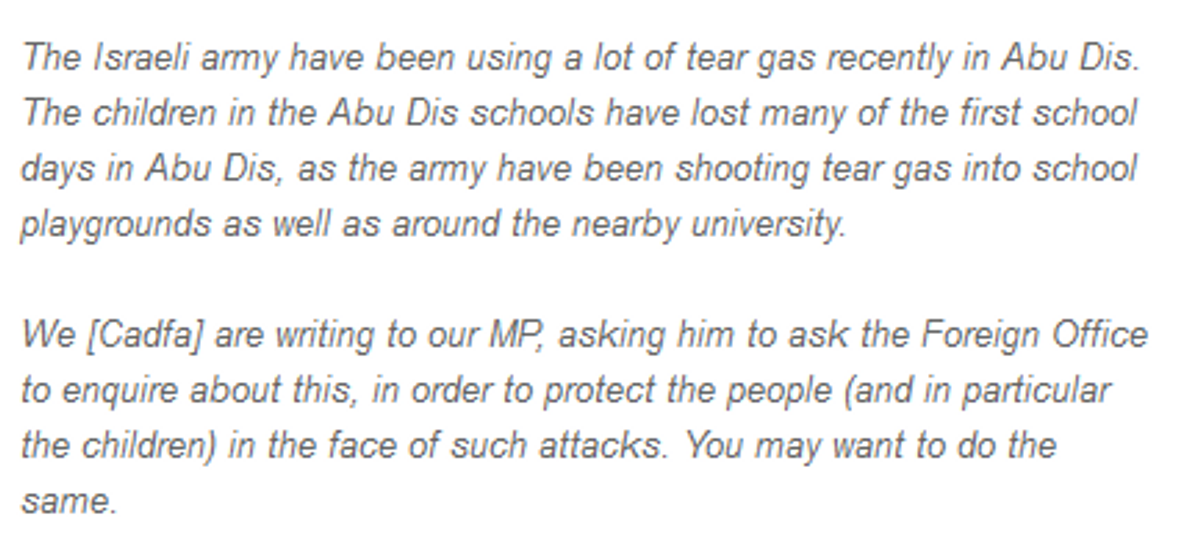
Just three months ago, CADFA launched a petition to announce an emergency, that “the people of Palestine are seriously in need of protection,” and that the situation in Palestine is fast getting worse and worse.
With tear gas all over the West Bank, surely CADFA would have a stern warning for any potential volunteers. CADFA actually has downloadable information documents for potential recruits, and even a special document for “health and safety issues relating to the Israeli occupation.” These, like the ISM documents, suggest the wares it is trying to sell do not reflect reality at all:

That extract clearly suggests that violence is neither widespread nor unpredictable. Additionally, it seems to imply that trouble occurs almost exclusively when demonstrators provoke it. With groups like ISM specifically turning up at potential trouble spots, these “peace groups” actually encourage violent confrontations. The second part of the CADFA safety document worth noting is this:
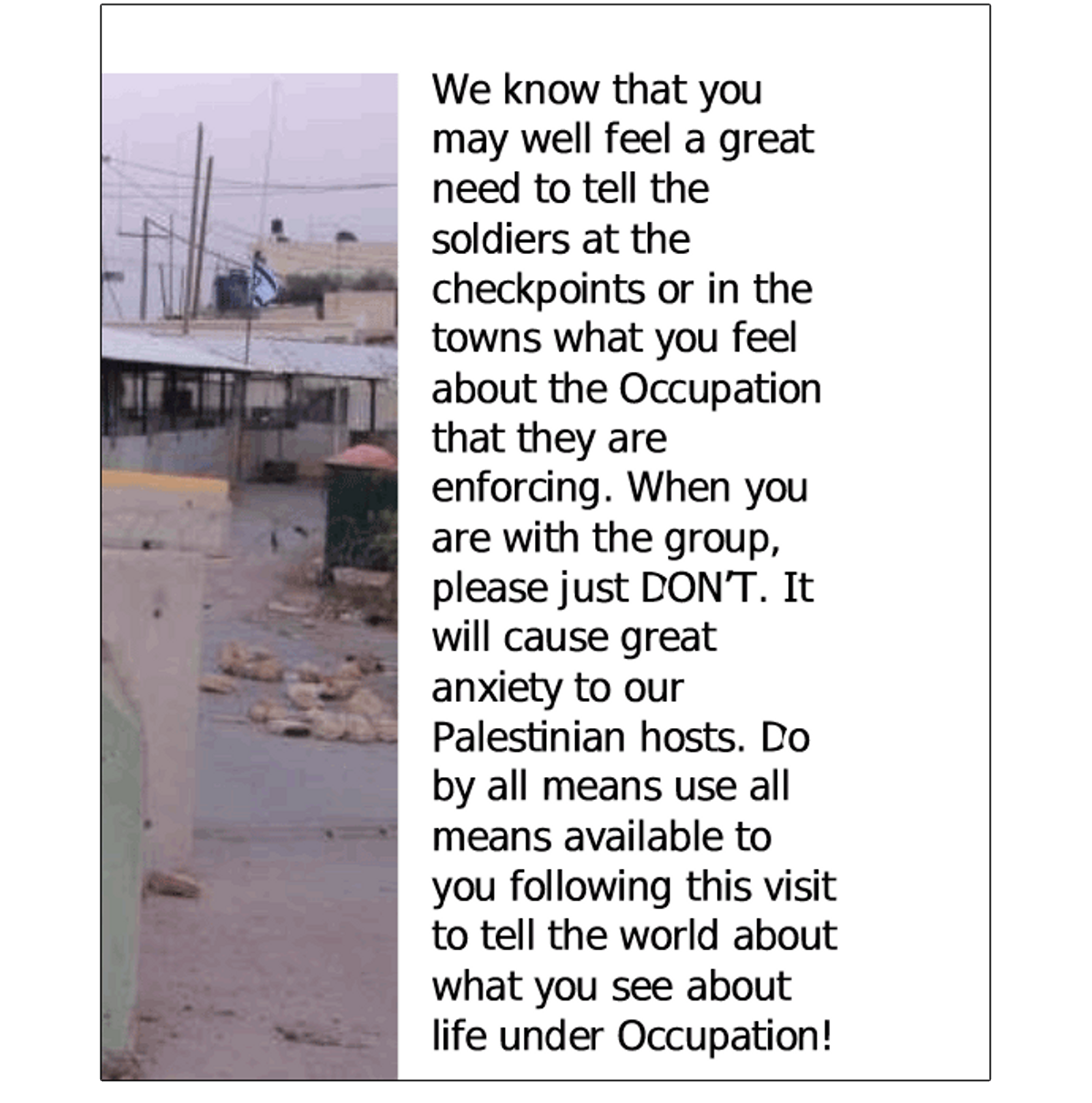
Of all the messages received to the emails and Facebook contacts (70 percent response rate), not a single group or NGO has suggested that random “danger” really exists or that safety should be a part of the decision-making process when deciding whether to volunteer.
***
In fact, Palestine is a perfect place for Westerners to volunteer. There is an opportunity to score serious virtue points in a world that places great value on such signaling. These areas are close to Europe, cheap to get to, incredible to travel around, sunny, and—most of all—secure. Given the proximity and cost, there are few better alternatives today to volunteering in Palestine and none working on the premise of humanitarian aid are anywhere near as safe.
Yet at the same time, most of the people arriving in Palestine have never seen conflict and have never left First World comfort. For them, the experience of volunteering with NGOs in Palestine is indeed as foreign as it is shocking. They cannot compare it to Syria, Somalia, or anywhere truly ravaged by war because they have never been to those places. All they can do is compare Nablus, Jericho, and Hebron to London, New York, or Berlin. Even though it’s perfectly safe, someone coming from the West is likely to view the life of the Palestinians as being harder than anything they have seen. And for as long they stay, that sense of hardship will be deliberately underlined and distorted. They see the “occupation”; therefore, the “occupation” must be responsible for all the hardship they witness. That the lives of those in the West Bank may be better than almost everyone else in the region does not cross their minds.
Enticed originally into Palestine by the warm encouraging words of the friendly adverts from NGOs, once back home, these ex-volunteers become important ambassadors for pro-Palestinian messaging. Suddenly the source of their information is not the warm advertising seeking humanitarian volunteers, but the far more aggressive lore spun by the solidarity campaign machinery. As they hear horrific tales of what is happening to the people who they dined and shared jokes with, they are driven to ever more extreme positions against Israel.
If you look today at the social media output of these ex-volunteers—people who lived in safety in the NGOs of Palestine—many now spread and share false tales of genocide and ethnic cleansing. To further increase the value of their virtue-signaling, they begin to retell their own time in “peaceful Palestine” somewhat differently. They become a functioning part of the propaganda machine. Most are given instructions and information packs instructing them to do this before they leave for home.
Then there are those who do not wait until they return home. One wonders just which West Bank Wendy was blogging from:
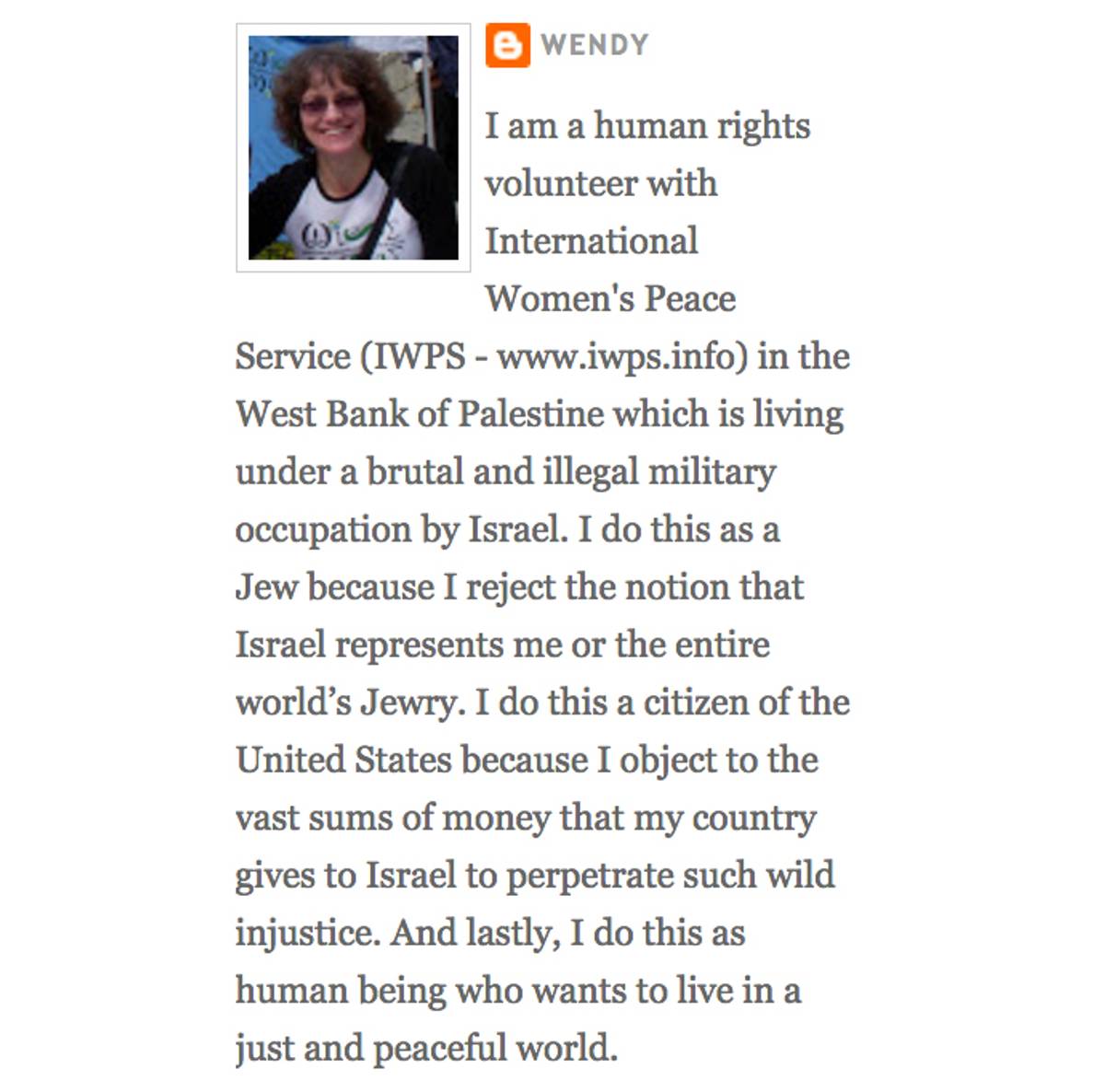

This one, from an ex-volunteer called Katie, is extremely informative:

Katie’s post highlights how full-on and immediate the propaganda and conversion process is. These blogs are not written by people on the ground who “know the truth,” but rather naive young adults who have swallowed propaganda whole. These blogs are not a consequence of the NGOs’ activities but rather a required and advertised activity that provides a vital service in spreading highly politicized and prefabricated disinformation. These ex-volunteers can cross lines that the NGOs cannot. They are also seen as more impartial and trustworthy than either Arabs or Jews—in part because they come from outside the region, and in part because their passion for justice is obviously real.
But manipulating young Western students with no sense of history who are legitimately shocked by realities that are harsher than those of their university dorms doesn’t take much in the way of political genius—simply a willingness to lie in the service of a cause. These NGOs knowingly mislead people who may truly believe the Palestinians are randomly being murdered in the streets—because they know they can lie and still receive funding from Western governments. It is time to state that many of these groups are openly and knowingly lying, with the intent of presenting an image that is simply not remotely supportable by the facts on the ground—a practice that only perpetuates the conflict.
It is notable that not a single one of the two dozen NGOs we looked at is actively calling on the Palestinians to negotiate, to talk peace, to stand behind a call for a multilateral cessation of all violence. Their purpose is to provoke, and in doing so they strengthen those elements of the Palestinian society that seek conflict and weaken those that do not.
***
You can help support Tablet’s unique brand of Jewish journalism. Click here to donate today.
David Collier is a freelance journalist based in London.